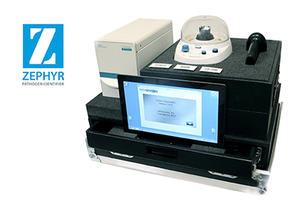DetectionPathSensors introduces portable pathogen identifier system
Baltimore, Maryland-based PathSensors, Inc. has introduced the portable Zephyr Pathogen Identifier system. The company says it delivers rapid, reliable detection of bacteria, virus, and toxins in powder and liquid samples in minutes. The Zephyr Identifier uses CANARY (Cellular Analysis and Notification of Antigen Risks and Yields) technology, which is licensed from the MIT-Lincoln Laboratory.

The Zephyr system delivers pathogen identification in minutes // Source: pathsensors.com
Baltimore, Maryland-based PathSensors, Inc., an environmental testing bioscience company, has introduced the portable Zephyr Pathogen Identifier system. The company says it delivers rapid, reliable detection of bacteria, virus, and toxins in powder and liquid samples in minutes.
The Zephyr Identifier uses CANARY (Cellular Analysis and Notification of Antigen Risks and Yields) technology, which is licensed from the MIT-Lincoln Laboratory. With CANARY biosensors, the rapid kinetics and signal amplification of cell-based signaling enables pathogen detection at sensitivities down to 50 cfu/pfu within five minutes.
Zephyr detects foodborne pathogens such as salmonella, E.coli, listeria, and campylobacter in dry foods, meats, and on food preparation surfaces — things which are significant issues for food producers. The company says that currently it is engaged in programs with the USDA and FDA to identify pathogens in poultry and plant materials.
“The portable Zephyr is as an easy-to-use, field deployable pathogen identification system, typically requiring less than a half hour of operator training,” explains Ted Olsen, president of PathSensors. “The user interface walks the operator through each assay step, making the system extremely user-friendly.”
PathSensors is currently working with other government organizations, including first responders, to deploy the portable Zephyr system in the field to provide detection of biological risks. “Typically, field samples are transported to regional laboratories for identification testing which can take critical hours,” Olsen explains. “Zephyr technology enables quick testing onsite in minutes.”
The company notes that at launch, it is offering reagents for rapid identification of the most common bio-threat agents. Initially, these pathogens include anthrax, ricin, botulinium toxin, smallpox, the plague, and tularemia.
The new Zephyr system expands PathSensors’ line of instrumentation which includes the BioFlash-AF Identifier for aerosol collection and identification of airborne pathogens in the ag-poultry environment, using a single sample.
PathSensors says it now offers a complete line of instrumentation that can identify biological agents in any sample matrix: powder, liquid, or aerosol. The instruments can be used as standalone or as part of an integrated biological detection system.
The existing product line also includes the BioFlash-E Biological Identifier, a high-volume aerosol sampler for building, event, and mailroom applications.
